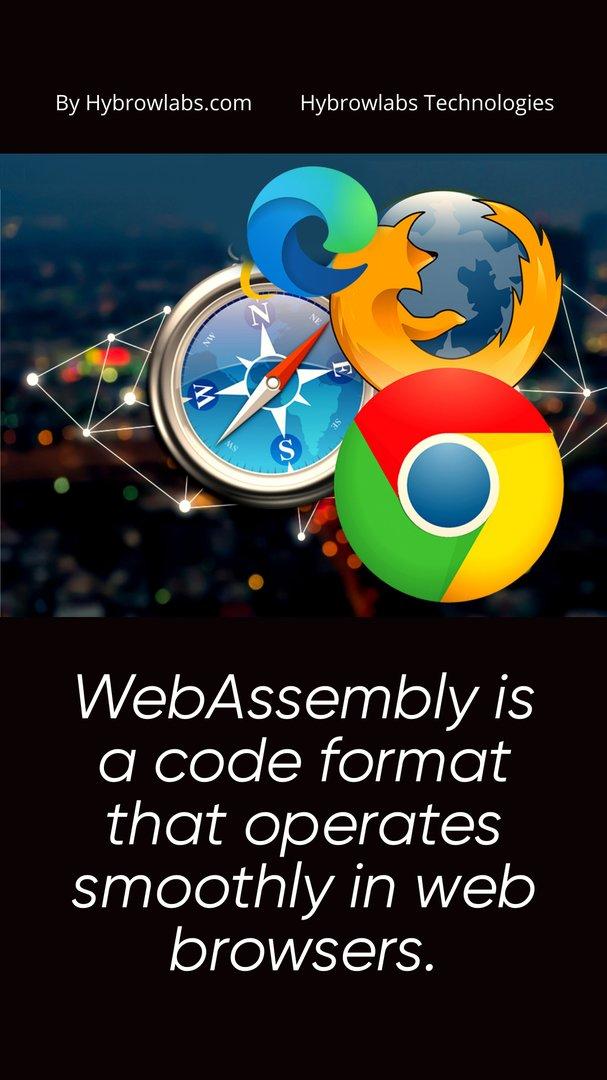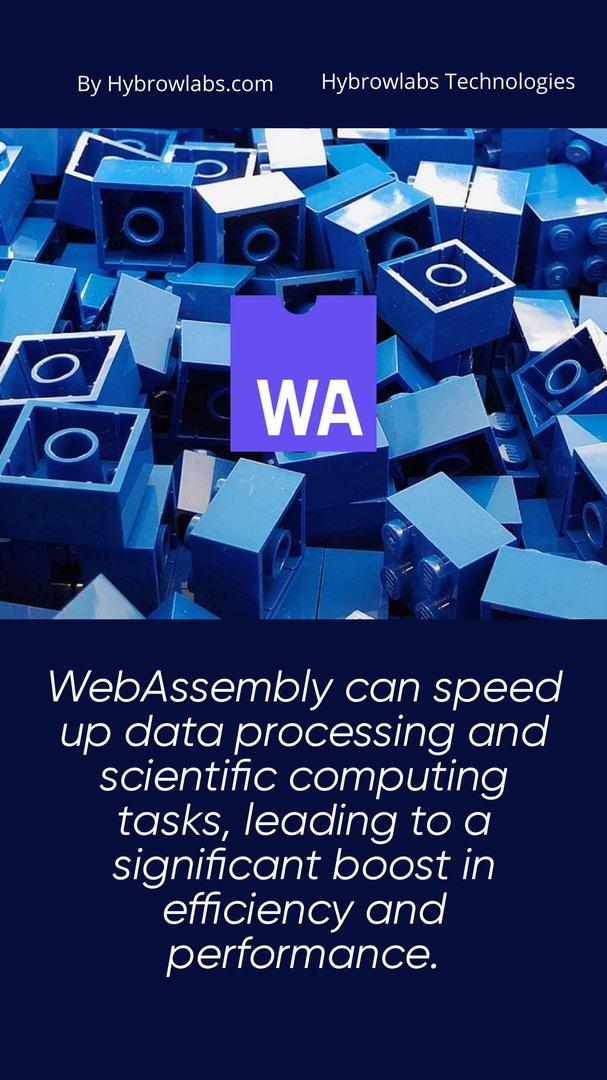Web Assembly: What it is?
WebAssembly, an influential instrument, has gained considerable traction since its launch in 2017. As a low-level bytecode format, it operates seamlessly in web browsers. It offers a portable, reliable, and effective method for code execution with performance rates almost identical to native speeds. This distinct attribute makes it well-suited for various sectors and applications.
Web Assembly Use Cases:

1. Gaming
WebAssembly can greatly enhance gaming performance by providing access to hardware resources and near-native velocity, enabling the creation of sophisticated and high-quality games that operate within the browser.
One primary advantage of WebAssembly in gaming is its ability to deliver faster loading times and seamless gameplay. Unlike conventional web technologies, such as JavaScript, WebAssembly provides an expedited startup time, substantially reducing the time to load and execute. Furthermore, WebAssembly can utilize multi-core processors and the graphics processing unit (GPU), enhancing the performance of games necessitating intensive computational tasks.
(i) Examples of popular games that use WebAssembly:
Numerous well-known games are currently utilizing WebAssembly to provide top-notch gaming experiences. One instance is the game "Minecraft," which uses WebAssembly for performance-sensitive aspects like simulation and rendering. In addition, the game "Quake 3 Arena" has been migrated to the web using WebAssembly, demonstrating the technology's potential to deliver a superior gaming experience within the browser.
(ii) Potential for WebAssembly to expand the reach of gaming to more platforms and devices:
WebAssembly also holds the potential to expand the accessibility of gaming to a broader range of platforms and devices. Using WebAssembly, game developers can design games that can function on different platforms, such as mobile and desktop devices, without requiring codebase rewrites for each platform. It substantially reduces game developers' development time and cost and provides gamers with an uninterrupted experience across various devices.
WebAssembly presents an exciting opportunity for game developers to create high-calibre games that can operate on multiple platforms while offering a seamless gaming experience to players. As the popularity of browser-based gaming continues to rise, WebAssembly is anticipated to play an essential role in shaping the gaming industry's future.
2. Multimedia:
WebAssembly offers an opportunity for faster and smoother multimedia playback by leveraging hardware resources and providing near-native performance. It can significantly enhance the user experience of multimedia applications, such as video players, by decreasing buffering times and increasing video playback quality.
A significant advantage of using WebAssembly for multimedia playback is its ability to utilize the graphics processing unit (GPU) for video decoding and rendering, enhancing multimedia applications' performance. Notably, this feature can significantly improve performance for high-resolution videos requiring intensive computation. Moreover, WebAssembly can decrease the overhead of JavaScript, further improving the overall performance of multimedia applications.
(i) Examples of multimedia applications that use WebAssembly:
Many multimedia applications are currently utilizing WebAssembly to provide top-notch video playback experiences. Among these is the video player "Bitmovin," which capitalizes on WebAssembly to facilitate accelerated and more efficient video playback on the web. Another instance is the music production tool "Bandlab," which leverages WebAssembly to enable real-time audio processing and mixing directly in the browser.
(ii) How can WebAssembly enhance user experiences for multimedia applications?
WebAssembly can amplify user experiences for multimedia applications by providing enhanced accessibility and cross-platform support. By implementing WebAssembly, developers can generate multimedia applications that function on various platforms and devices without requiring platform-specific APIs or plugins. It can considerably improve the accessibility of multimedia applications and also guarantee users a smooth experience across various devices.
WebAssembly presents an enthralling opportunity for developers to conceive of high-performance multimedia applications that can operate in the browser while ensuring users encounter a seamless and easily accessible experience. As the call for multimedia applications keeps burgeoning, WebAssembly is poised to take on an increasingly significant role in the future of the multimedia industry.
3. High-Performance Computing:

By offering a mobile and effective execution environment for applications that require significant processing resources, WebAssembly presents a promising alternative for high-performance computing jobs. This cutting-edge technology can potentially change the execution of computationally heavy tasks like scientific simulations, data processing, and machine learning thanks to its capacity to exploit hardware resources and achieve near-native speed.
Due to its low-level architecture and near-native speed, WebAssembly offers several advantages over conventional web technologies like JavaScript for high-performance computing activities. Moreover, WebAssembly can accelerate data processing and scientific computing by using hardware resources like GPUs and multi-core computers. Compared to other web technologies, this leads to a considerable boost in efficiency and performance.
(i) Examples of applications that use WebAssembly for high-performance computing:
There are already various applications that utilize WebAssembly for high-performance computing tasks. For instance, the "TensorFlow.js" library, employed for machine learning operations, leverages WebAssembly to expedite the execution of machine learning models on web browsers. Another example is the "Emterpreter," a WebAssembly-based interpreter that provides near-native performance for JavaScript code. This interpreter enables swifter and more efficient data processing tasks to be carried out in web browsers.
(ii) Potential for WebAssembly to accelerate data processing and scientific computing tasks:
Especially for applications that call for intense computation, WebAssembly can potentially speed up data processing and scientific computing workloads. WebAssembly allows programmers to design more complex and computationally intensive online applications while significantly improving the performance of these tasks through its ability to exploit hardware resources and give near-native speed.
WebAssembly offers a promising future for high-performance computing activities on the web. As more applications use this technology, it is anticipated to play an essential role in developing scientific computing and data processing.
4. Internet of Things:

Because it offers an efficient and lightweight execution environment for IoT devices, WebAssembly can be used for the Internet of Things (IoT). Because of this, IoT application developers may be able to construct programmes that function almost as well as native software on various hardware platforms with little processing power and memory.
Because it can provide a uniform execution environment across many devices, regardless of their underlying hardware and operating system, WebAssembly is one of the most advantageous programming languages for Internet of Things applications. As a result, the creation and deployment of IoT applications can be simplified to a great extent, and developers are allowed to construct IoT applications that are more intricate and advanced.
(i) Examples of applications that use WebAssembly for the Internet of Things:
Due to its effectiveness and adaptability, WebAssembly has emerged as a favourite Internet of Things (IoT) technology. Wasm3, a compact and highly effective WebAssembly runtime for embedded devices, and Eclipse Edge Native, a project offering a runtime environment for WebAssembly on edge devices, are two examples of IoT applications already employing this technology. As a result, the system's efficiency is increased by enabling the deployment of sophisticated IoT applications at the network's edge.
(ii) Potential for WebAssembly to the Internet of Things:
The adoption of WebAssembly in the IoT sector offers tremendous opportunities for creating cutting-edge apps that can function on hardware with constrained memory and processing capability. The creation and deployment of IoT applications are further facilitated by web assembly's universal execution environment, which is agnostic of hardware and operating system.
This technology is a bright promise for IoT application development and deployment. As its adoption rate grows, it will likely become a critical component of the IoT industry's future.
5. WebAssembly and Blockchain:
For the fast and effective execution of smart contracts on Blockchain, WebAssembly is available. On a Blockchain network, smart contracts are computer programmes that may be automatically performed, simplifying several operations and procedures. With WebAssembly, programmers can construct intelligent contracts that work with different Blockchain platforms and run virtually as quickly as native code.
Smart contracts can be executed in a more secure and effective environment thanks to Blockchain's WebAssembly. It is because WebAssembly, a low-level bytecode format, may provide smart contracts with more security and performance than traditional scripting languages. Furthermore, WebAssembly enables the development of more intricate and complex smart contracts, enabling programmers to create more potent decentralized apps.
(i) Examples of applications that use WebAssembly for Blockchain:
WebAssembly is already being utilized in several applications for Blockchain. For instance, the "NEAR Protocol" adopts WebAssembly as its smart contract language. Meanwhile, the "Polkadot" network uses WebAssembly as its smart contract execution environment. Furthermore, the "EOSIO" Blockchain platform supports WebAssembly as its smart contract language.
(ii) Potential for WebAssembly to the Internet of Things:
By providing a more effective and safe environment for smart contract execution, WebAssembly has the potential to transform the Blockchain sector completely. Developers can build more sophisticated and potent decentralized applications with WebAssembly, enhancing the overall functionality and usefulness of Blockchain networks.
In conclusion, WebAssembly presents a strong possibility for the Blockchain sector. As more applications adopt it, it is anticipated to be essential for creating smart contracts and decentralized applications.
Conclusion:
The low-level bytecode structure of WebAssembly, which offers portability, safety, and efficiency for running code at close to native rates, makes it a flexible tool utilized in various industries and applications. It is excellent for high-performance applications, including gaming, multimedia, HPC, IoT, and Blockchain.
WebAssembly is a promising technology with many applications and prospective use cases. Thus, we invite readers to learn more about it and its potential. WebAssembly is something you should look into if you're a developer or just interested in current technological advancements. We can anticipate more intriguing use cases for WebAssembly as 2023 goes on, as developers continue to study and enhance its features.
FAQ's:
1. What are the first steps for developers using WebAssembly?
A: Beginning WebAssembly developers can build WebAssembly code using a compiler by learning one of the supported languages, such as C++ or Rust. They can also streamline the development process using WebAssembly frameworks like wasm-Bingen or AssemblyScript.
2. How significant is WebAssembly?
A: Many businesses find WebAssembly an appealing alternative since it enables developers to build high-performance online applications that can do complicated computations in real-time.
3. Why should I choose WebAssembly over more conventional web technologies?
A: A few benefits of adopting WebAssembly over conventional web technologies are as follows:
- Performance: WebAssembly offers a quick and responsive user experience by running complicated apps at near-native speeds.
- WebAssembly is a portable technology that may be used on any platform supporting current web browsers.
- Security: WebAssembly operates in a safe environment known as a "sandbox," which prevents harmful programmes from accessing confidential data.
- Language-neutral: WebAssembly works with any programming language, letting developers use their current knowledge and resources.
4. What problems may you run into when using WebAssembly?
A: The following list of difficulties with WebAssembly:
- Tooling: Because WebAssembly is a newer technology, there are few tools for developers to use.
- WebAssembly apps can be challenging to debug since the code is compiled into a binary format that is difficult for humans to read.
- Most contemporary browsers support WebAssembly, but some compatibility difficulties with older versions can exist.
- Web assembly code can be larger than identical JavaScript code, which may result in slower web application loading times.






a3dc85.jpg)

.jpg)
fd8f11.png)


.jpg)
.jpg)